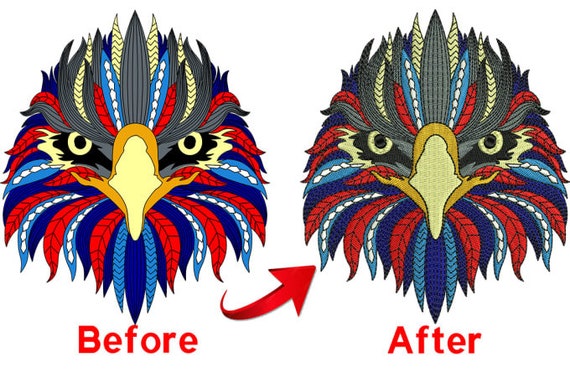Simplifying the Art of Embroidery Digitizing: Step-by-Step Overview
Needlework digitizing is a careful craft that requires precision and imagination. As innovation proceeds to advancement, the digitization procedure has actually come to be more available, enabling lovers to bring their detailed layouts to life with ease. In this overview, we will decipher the complexities of embroidery digitizing, breaking down each action carefully to enhance the procedure and encourage both novices and experienced embroiderers alike. Stay tuned to uncover exactly how you can simplify this detailed art type and transform your imaginative visions right into perfectly embroidered masterpieces.
Recognizing Embroidery Digitizing Software Program
Embroidery digitizing software application functions as a crucial tool for changing elaborate layouts into digital layouts compatible with embroidery machines, promoting precise stitching and modification. This specialized software application permits users to import different picture documents formats, such as JPG or PNG, and convert them right into needlework machine-readable layouts like DST, EXP, or PES - Digitizing for Embroidery. By utilizing functions like stitch editing, underlay alternatives, and thread shade selection, digitizing software allows customers to regulate every facet of the design process
Furthermore, advanced needlework digitizing software program offers tools for creating complex designs, changing stitch density, and integrating detailed details. Users can also preview the design before stitching it out, ensuring precision and lessening mistakes. Furthermore, lots of software application give automated functions that assist streamline the digitizing process, conserving effort and time.
Recognizing the capacities of needlework digitizing software application is necessary for achieving high-quality lead to needlework jobs. By grasping this tool, needlework enthusiasts and specialists can unleash their imagination and bring elaborate designs to life with accuracy and performance.

Picking the Right Style Data
After familiarizing yourself with the capabilities of needlework digitizing software program, the following crucial step in the procedure is picking the appropriate layout data for your project. Digitizing for Embroidery. When choosing a style data for embroidery digitizing, it's vital to think about the complexity of the layout, the dimension of the end product, and the sort of textile you will certainly be dealing with
For elaborate designs with fine details, a high-resolution image or vector documents is advised to ensure that the embroidery machine can properly replicate the design. In addition, the size of the final item plays a considerable role in selecting the appropriate layout file. Bigger designs may need greater resolution files to keep clearness and sharpness.
Furthermore, the kind of fabric you will certainly be stitching on influences the option of layout documents. Different materials might require changes in the design data to make sure that the stitches are properly lined up and the style looks like planned. By very carefully picking the right style data based upon these factors, you can set yourself up for a successful needlework digitizing process.
Digitizing Tools and Methods
Making use of specialized Full Article software and precision methods, digitizing tools are crucial in transforming elaborate layouts into embroidery-ready files. Embroidery digitizing software, such as Wilcom, Hatch, or Embrilliance, offers the essential system to convert artwork right into stitch data. These programs offer features like stitch modifying, rug choices, and lettering tools to guarantee the style equates effortlessly onto material.
One of the essential methods in digitizing is producing a clear path for the embroidery machine to follow. This involves digitizing each element of the design with accuracy, establishing stitch kinds, thickness, and instructions. By utilizing devices like digitizing tablet computers or software-specific plugins, embroiderers can accomplish a high level of accuracy in their digitized layouts.
In addition, understanding the art of rug stitching is important for creating quality needlework. Underlay sewing supports the fabric and creates a structure for the style, guaranteeing that the end product is both visually enticing and durable. By comprehending these digitizing tools and strategies, embroiderers can boost their craft and bring elaborate designs to life with accuracy and my sources effectiveness.
Customizing Stitch Kinds and Directions
Having actually developed a foundation in digitizing tools and strategies, an essential element beforehand needlework craftsmanship depends on tailoring stitch types and directions with accuracy and purpose. The option of stitch kinds can dramatically affect the overall look and texture of the stitched design. Satin stitches, understood for their smooth and shiny surface, work well for creating borders and message. On the various other hand, fill stitches are suitable for covering larger locations successfully. By tactically incorporating these stitch types, embroiderers can attain depth and dimension in their layouts.
In addition, the direction of stitches plays a vital function in boosting the aesthetic allure of the last needlework. By trying out with various stitch angles and patterns, embroiderers can bring their styles to life with exceptional information and details.
Screening and Refining Your Digitized Style
To make sure the accuracy and quality of your digitized design, extensive screening and improvement are crucial action in the needlework digitizing process. Once you have finished the digitization of your layout, it is vital to check it see here now before proceeding with the actual embroidery. Examining permits you to determine any type of potential concerns such as string breaks, stitch density problems, or layout distortions that might impact the final outcome.

After testing, it is necessary to improve your digitized layout based upon the feedback from the examination sew-out. This might involve tweaking sew setups, adjusting thickness, or making changes to the overall layout to attain the preferred outcome. By repeating through screening and improvement, you can fine-tune your digitized layout to perfection before progressing with the real embroidery process.
Verdict
Finally, grasping the art of needlework digitizing needs an extensive understanding of the software, picking the best design data, utilizing digitizing devices and techniques, personalizing stitch types and instructions, and testing and fine-tuning the digitized layout. By complying with these actions, embroiderers can simplify the digitizing procedure and create high-grade embroidered layouts with precision and effectiveness.
Comments on “Premier Digitizing for Embroidery: Perfect Stitch Each Time”